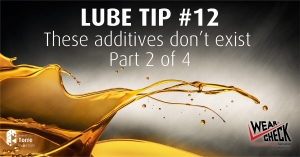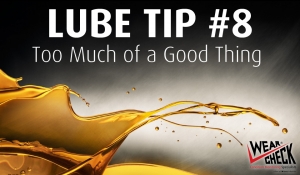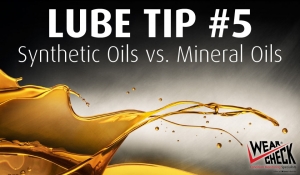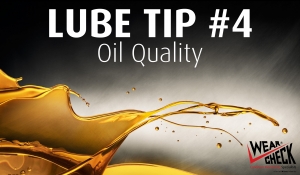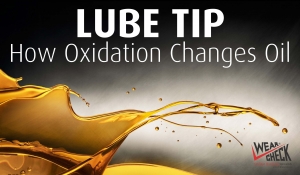Displaying items by tag: WearCheck Lube Tip
Lube Tip 12: These additives don’t exist - Part 2
Part 2 of 4
WRONG-OIL FORGIVER Lubricants and their additives do not automatically adjust to the environs and needs of the machines within which they are placed. There are thousands of different lubricant formulations on the market for a reason. They are not alike, and they don’t perform alike and, hence, users will not receive like results. Precision lubrication is about precisely selecting the right lubricant for the target machine and making sure that particular lubricant is always used and then replaced before its life is done.
WATER ZAPPER Water exacts an evil curse on lubricants and machines. It accelerates wear, corrosion, microbial growth, friction, additive depletion, aeration, varnish, oxidation . . . and, well, the list goes on and on. Outside of the limited capability of rust inhibitors, additives don’t stop the penetration and damage exerted by water. Only controlling the invasion and dispersion of water in our lubricants solves these problems.
OIL STARVATION PAIN-KILLER Despite the assertions of some late-night television infomercials, additives are not a solution for starved oil supply or low oil levels. Lubricants service many functions beyond simply controlling friction and wear. As such, they need to be present as an entire formulation, not simply a few chemical remnants clinging to the frictional surfaces of our machine.
LUBE TIP by Jim Fitch of Noria Corporation
Lube Tip 8: Too Much of a Good Thing
When using oil additives, more is not always better. As more additive is blended into the oil, sometimes there isn’t any more benefit gained, and at times the performance actually deteriorates. In other cases, the performance of the additive doesn’t improve, but the duration of service does improve.
In addition, increasing the percentage of a certain additive may improve one property of an oil while at the same time degrade another. When the specified concentrations of additives become unbalanced, overall oil quality can also be affected. Some additives compete with each other for the same space on a metal surface. If a high concentration of an anti-wear agent is added to the oil, the corrosion inhibitor may become less effective. The result may be an increase in corrosion-related problems.
From: The Critical Role of Additives in Lubrication, by Pete Oviedo, Noria Corporation
Lube Tip 5: Synthetic Oils vs. Mineral Oils
Query: “Relating to gearboxes on trucks, if the owner/ driver doesn’t know if the gear lubes are synthetic, is there a fool-proof way to determine this without having to send a sample to the lab? Some oil manufacturers colour their synthetic oils, while others don’t. What would happen if the oils were to be mixed or topped up with the wrong oil?”
WearCheck’s answer: The colour of the lube is simply a dye. There are no standards, and manufacturers can and do change colours whenever they please. Unfortunately, there is no reliable way of differentiating between mineral and synthetic in the field. However, because synthetic base oils are white (meaning transparent) as compared to mineral oils, which have a darker natural colour (due to aromatics, sulphur and other impurities), this may be a distinguishing factor. Note, however, that despite the fact that the base oil of a synthetic is white, the additives can add considerable colour (darkening) to the finished oil.
In the laboratory, you could distinguish synthetics from mineral oil by looking at a combination of physical properties including VI, flash point, pour point and aniline point. There may also be different elemental additive chemistry.
Generally, in the type of application you are talking about, the synthetic gear oil will likely be polyalphaolefin (PAO) based. PAOs are very similar chemically to mineral oils, so mixing the two should not cause a compatibility problem, especially if both oils are the same API classification.
However, if a synthetic is required, such as for cold-temperature operation, using a mineral by mistake may cause other problems.
Also, be aware that in industrial applications, some synthetic gear oils are polyglycol (PAG) base stocks, which are chemically incompatible with both PAO synthetics and mineral oils. In this case, mixing will result in serious incompatibility issues.
Lube Tip 4: Oil Quality
An inferior base oil cannot be converted into a premium product simply by the inclusion of an additive. Using a poor-quality oil on a continuing basis and attempting to overcome its poor lubricating qualities with some special additive is illogical. It is better to determine the manufacturer's recommendation as to the minimum API service rating required and then regularly use a blended lubricant of a higher service classification than originally recommended, if an improvement in lubrication is the objective.
From "The Practical Handbook of Machinery Lubrication"
Lube Tip: How Oxidation Changes Oil
How oxidation changes oil
Once the oxidation process occurs, five major changes in the oil result in the following:
- Colour becomes darker – changes from transparent or translucent in colour to some degree of discoloration toward the point of complete opacity.
- Odour becomes pungent and acetic due to the presence of excessive organic petroleum acid and similar products of oxidation.
- Acidity increases – changes from a neutralisation number from 0.06 to 0.12 KOH mg/g to well above 2.0 can occur.
- Viscosity increases – the viscosity of an oil frequently may double or triple due to oxidation. Oxidative thickening is capable of producing fluids that have the consistency of molasses-like sludge under high operating temperature conditions.
- Insolubles precipitate (sludging occurs) – after an induction period, the deterioration of an oil gradually accelerates until the formation of organic acids of deposition of sludge completely destroys the oil.
Courtesy of Noria Corporation.

